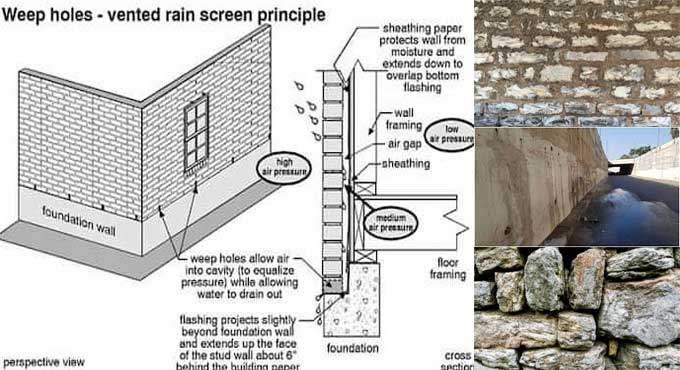
The Weep Hole Construction Process in Retaining Walls

The purpose of weep holes is to allow rainwater to drain from structures like retaining walls, buildings, and cavity walls. By reducing buoyancy, weep holes uplift structures and make them stronger and more stable. Surface tension should be decreased by sizing weep holes appropriately.
Walls are designed with weep holes to allow water to drain through them. These holes are found in masonry walls, retaining walls, underpasses, wings, and other ground drainage structures.
The structural design demand for water and earth pressure is decreased by decreasing the thickness and strengthening requirements.
Weep Holes Workflow
Water can be drained from weep holes through penetration, capillary action, or leakage from the backfill of the wall. Weep holes are constructed in brick masonry as a vent to relieve dampness and regulate mildew, to prevent dry rot, and to prevent mildew from growing in brick. There are often weep holes in the outer masonry of cavity walls.
It is also possible for them to be located above the cavity walls. It is common to keep them at common intervals so that water can be drained. There should be a 45 cm gap between weep holes. Weep holes are designed as engineering solutions to reduce wet wall pressure resulting from hydrostatic pressure.
Furthermore, weep holes reduce buoyancy and uplift on the structure, making it possible to build lighter structures without any stability issues associated with uplift.
Importance of Weep Holes
In the event that the walls are built above the water table then there will be no chance of water accumulating behind the walls. In this case, the condition of the weep holes is not relevant.
If, the structure is built below the water table, it will be subject to surplus pressure of water and weep holes will need to be provided during construction. Underpasses, bridges, retaining walls, wing walls, external brick walls, and underpasses have weep holes to release hydrostatic pressure generated by these structures.
Weep Holes Types
Cotton Rope Wicking
Using a rope 12 inches in length, cotton rope-wicking weep holes can be created. Weep holes of this type are installed in joints and their other ends are extended into cavity walls. It is absorbed by the cotton on the back of the wall and evaporated on the other side. Other types of weep holes require more energy than this method.
Open Head Joint
People with open head joints are provided with water flowing out of their joints by Living. Open weep holes of the same size as the typical joint spacing are called these types of weep holes. An open hip joint weeps hole that is provided in order to evaporate water from the cavity, open head joints are a common and effective method.
Tubes Weep Holes
Tube wells are created using hollow plastic or metal tubes that are placed around 16 inches apart from one another. It is important to take care that the angle is not too steep while installing the Tube weep holes so that water may drain out freely.
To stop water from draining through clogged tube weep holes, a thin coating of gravel may occasionally be placed.
Weep Holes in Retaining Holes Functions
Rainwater can be drained from the retaining wall asset by installing weep holes. To drain the water lodged on the retaining wall, weep holes are provided on the bottom side. Make weep holes in the retaining wall asset to decrease buoyancy, and uplift the structure to make it more stable and strong.
It is possible to prevent further damage to the walls by creating weep holes in the retaining walls. Moisture is kept out of the retaining wall by weep holes. Ventilation in retaining walls also serves as its main objective. It is mostly used to decrease the hydrostatic pressure formed in the walls by providing weep holes.
Weep Holes Merits
Retaining wall water lodges must be allowed to drain. Water lodged in the pipes, resulting in reduced hydrostatic pressure. It makes sure the surface is protected from moisture and damage & makes dampness control possible. A ventilated cavity in the internal wall should be provided.
Weep Holes Demerits
Pest Problem
Walls can be reached through down lights, ventilator fans, and holes for plumbing and electric use. Having weep holes can provide rodents and insects with access to your house. Baffled vents can decrease this problem easily.
Trash Mortar Blockage
Brick masonry is kept intact when holes are kept in it. During construction, mortar can fall out between successive courses of bricks and into the weep holes. Weep holes can be closed partially or completely by waste mortar.
To learn more, watch the following video tutorial.
Video Source: Digitech education
Airflow Obstruction
While weep holes may be visually pleasing, they may not provide the necessary air flow to properly ventilate the interior brick wall, reducing the above issues of pest entry and waste mortar.


